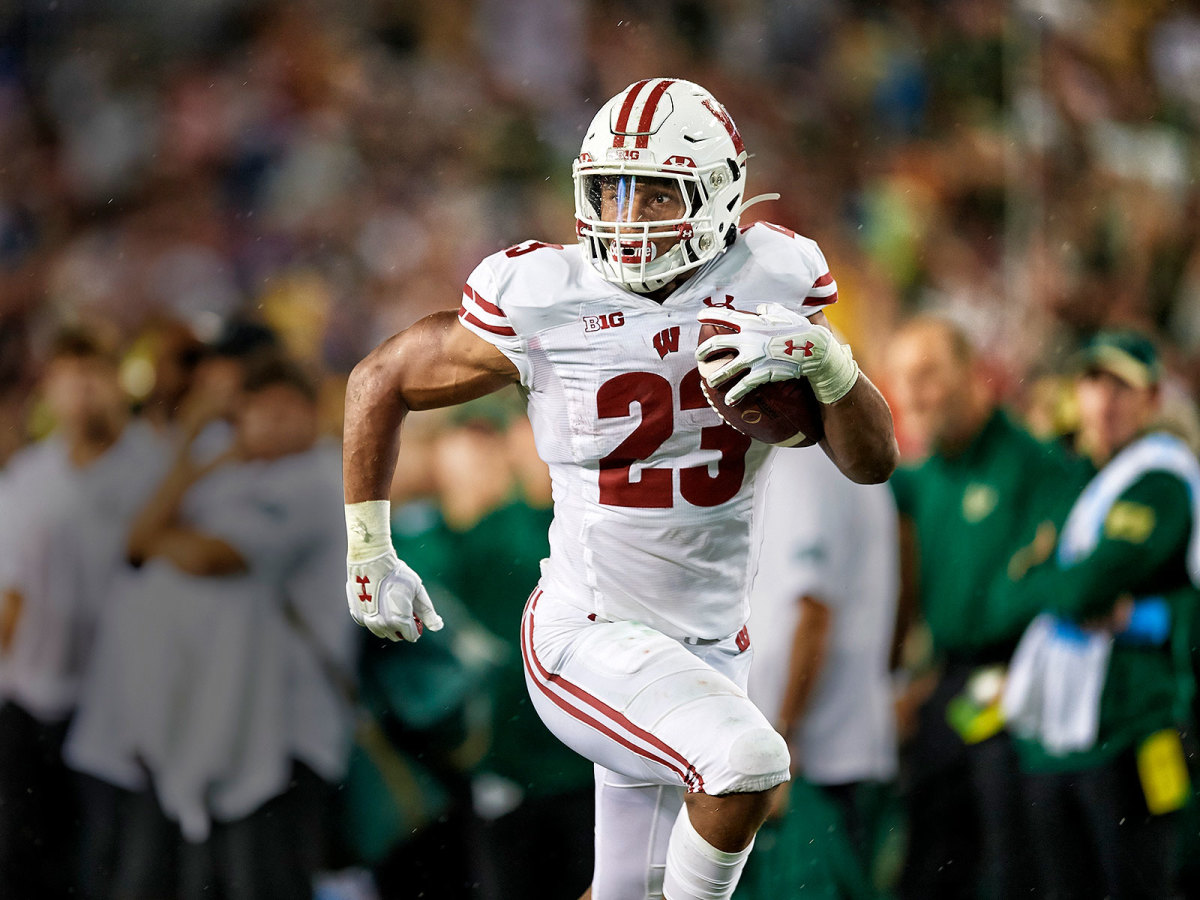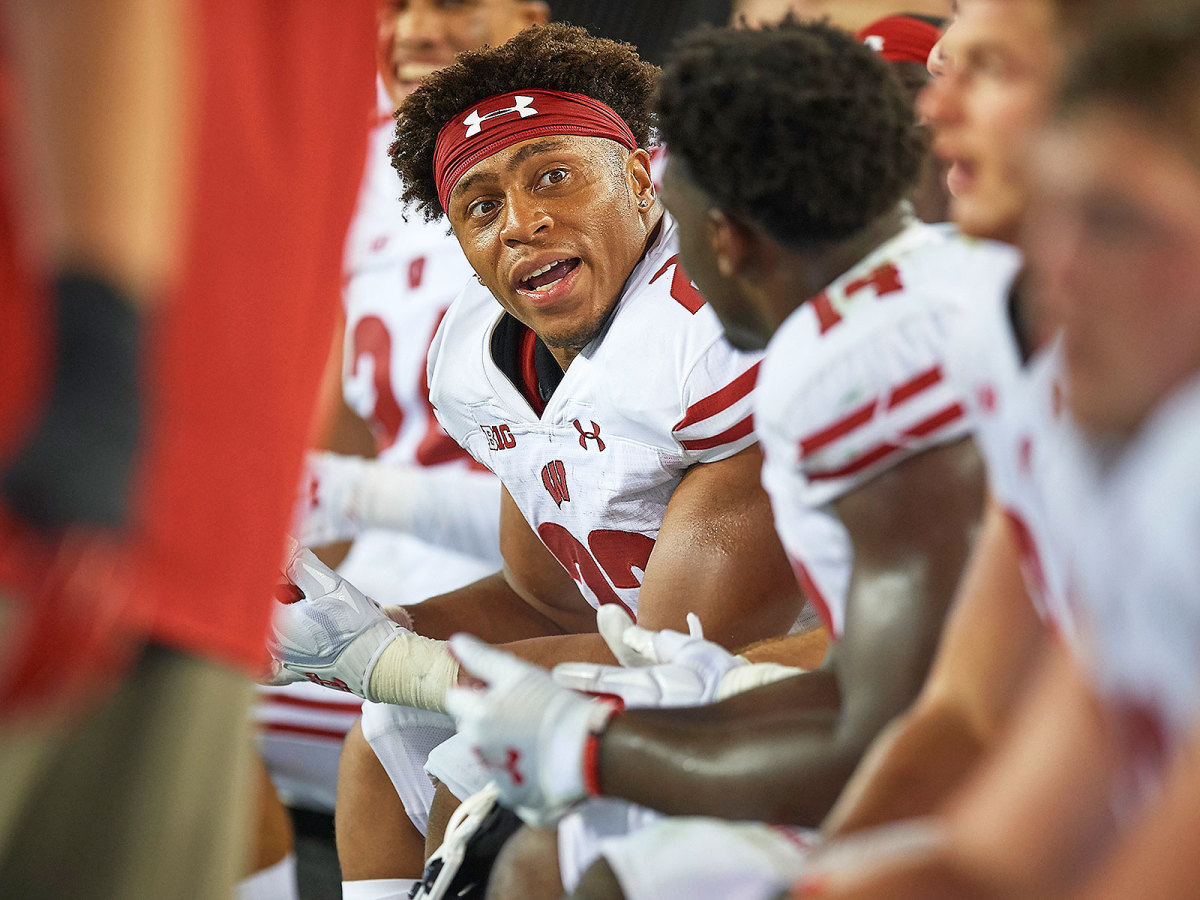The Insatiable Curiosity of Jonathan Taylor Drives His Relentless Dominance

This story appears in the Sept. 23, 2019, issue of Sports Illustrated.For more great storytelling and in-depth analysis, subscribe to the magazine and get up to 94% off the cover price. Click here for more.
When Jonathan Taylor was a senior in high school, he received a special graduation present from his family: a telescope. Pressed to his eye and pointed to the heavens, the high-tech gadget became an extra appendage. Says Taylor's father, Jonathan James, "That's when I knew he was different."
Different. Everyone from Taylor's running backs coach at Wisconsin to his track coach at Salem (N.J.) High to his teammates in Madison uses that word to describe him. It's a compliment as much as an admission: None of them understand how the 5'11", 219-pound junior—the leading nonquarterback in the Heisman Trophy race—does what he does on the football field. His vision and speed were on full display in the Badgers' 49–0 win over South Florida on Aug. 30, as Taylor rushed for 135 yards and two touchdowns. He also had the first two receiving TDs of his career. His performance inspired reigning NFL MVP Patrick Mahomes to tweet, "Jonathan Taylor for Heisman," a fact that wowed the running back when he heard about it after the game.
Taylor remains fascinated by celestial objects, but now he's equally eager to learn about transcendental idealism, the physics of crane pose and the myriad ways he can help his offensive linemen. That drive and curiosity have propelled him from tiny Salem (pop. 4,774) to 80,321-seat Camp Randall Stadium, from a cinder track without proper markings to a state championship, from a three-star football recruit to the reigning FBS rushing champ and Doak Walker Award winner. At Wisconsin the stargazing Taylor has become the supernova in everyone's sights.

Salem sits at the end of New Jersey Route 45, hard by the border of Delaware in the state's most rural corner. Taylor's parents, Jonathan James and Elizabeth Taylor, never married, but both were instrumental in raising him; Taylor lived with his mother and four older siblings. His graduating class at Salem High had just 69 students, and the football team hasn't won a state championship since 1983. In 2012, the season before Taylor enrolled, the Rams went 0–10.
Taylor became a football player almost by accident when he was in fifth grade. His cousin Amani Justice, who is the same age, started playing, so Taylor tried out too. By his junior season of high school he became the centerpiece of a run-heavy offense while also playing linebacker. That was good enough for the honor roll student to attract interest from Wisconsin and Harvard, as well as a scholarship offer from Rutgers.
"There were some things missing," says Badgers running backs coach John Settle. "We liked him, didn't love him, so to speak." Settle wanted to see breakaway speed and encouraged Taylor to continue working with the track team. Devote yourself to track this spring, the Wisconsin coaches said. You have the strength, but we need to see an extra jolt of speed.
Taylor had never been serious about sprinting and as a sophomore was "a marginal runner at best," says Salem track coach Mark Anderson. But in the spring of '16 he began working hard on the track, in the weight room and on Google, researching techniques that could make him faster and quizzing his coach about them. Can I use a toe drag start, Coach? Anderson said Taylor could experiment with the concept, popularized by Usain Bolt, but the approach didn't fit with Taylor's mechanics. Still, Taylor's times kept dropping.
He committed to Rutgers on May 1, but Settle still attended the SJTCA Track and Field Carnival meet four days later to see Taylor run. The coach almost wasted his time, as Anderson came close to benching Taylor for being late to a practice earlier in the week. The morning of the race Taylor appealed to his coach, telling him Settle would be there to watch. Anderson relented, and Taylor dazzled, winning the 100 meters in 10.73 seconds.
The next fall Taylor put his newfound speed to good use. He finished with 2,815 rushing yards, breaking the New Jersey high school single-season record set by Corey Clement, who also went on to play for the Badgers. Taylor's efforts helped the Rams go 10–3 and reach the state final. "All of a sudden the long runs he was making his junior season became touchdowns," Settle says. "The long touchdowns, he was running away from people. By the second or third game [of his senior season] I was like, Let's offer him." (Taylor decommitted from Rutgers and signed with Wisconsin on Nov. 1 of that season.)
In the first months of his freshman year in Madison, the habitually inquisitive Taylor became an object of curiosity himself. He had rushed for 223 yards in Week 2 against Florida Atlantic, then 249 three weeks later at Nebraska, and reporters wanted to know: Who was he? But even Taylor wasn't sure. One week he wanted to study astronomy; the next, physics. Eventually he enjoyed an ethics class enough to declare as a philosophy major.
Taylor is always happy to discuss his favorite philosopher, the 18th-century German metaphysician Immanuel Kant, and his study of moral objectives. The junior is also fascinated with the semantics of questions. His philosophy courses have taught him that the way a question is asked can have various implications, and he's used his knowledge in the running backs room to analyze plays from different perspectives. "You might take a step back and ask, 'What if this position does this? Does that change me at all?'" he says. "You look at the whole picture. I think that's what philosophy helps you do.
From almost the start of his first fall camp, Taylor got reps. He learned the playbook quickly, which earned him time playing with the No. 1 offense. Quarterback Jack Coan, who came in with Taylor, recalls one particular handoff that preseason. The freshmen were going up against the Badgers' first-team defense—a unit that would rank second in the FBS in yards allowed per game in 2017—and Taylor took the ball nearly 80 yards for a touchdown. "Later in the practice," Coan says, "[Taylor] was going with the [first unit], and he one-handed a screen and took it, like, 70 yards or something. From there on, he was Jonathan Taylor."
As in: the Jonathan Taylor who set the FBS single-season freshman rushing record with 1,977 yards, averaging 6.6 yards per carry and scoring 13 touchdowns. He seemed to have vision that most backs take years to develop, sensing holes before they opened, staying one step ahead of the linebackers he manipulated like pawns. "You really have to do a lot more thinking and preparation at this level," Taylor says. But he draws a line between preparing and overthinking. "Once you're relaxed, if you try too hard to predict instead of just reacting, it's [a mistake]," he says.
Watching film, Taylor breaks down his runs almost as quickly as his legs can churn. While analyzing a 29-yard burst against Florida Atlantic in 2017, he raises his eyebrows as the footage shows him breaking a tackle in the backfield, then three more on the edge before outracing a fifth defender. "You've just got to keep your feet moving," he says. "[Make] sure you give them a small area to hit." The words are barely out of his mouth before he's seen dropping his right shoulder and breaking free, accelerating through contact and into the end zone.
As a freshman, Taylor studied the game so that he could trust his gut. He focused on his role as the Badgers' first- and second-down guy, and nothing more. The next season Taylor played a much bigger role, to say the least. The sophomore had 2,194 rushing yards, best in the nation, gaining 7.1 per carry even as Wisconsin struggled so much in the passing game—finishing 11th in the Big Ten in that category—that opponents concentrated on trying to stop him. Taylor asked his linemen how he could ease their burden, learning ways to help their blocking schemes and move linebackers with his routes. He knows that his job is to run as close to his lineman as possible to bring the defender to him.
He also began to work on his receiving skills, which will be an even bigger focus for him this fall, as he aspires to become a more complete player. Now that Alex Hornibrook has transferred to Florida State, Coan will start behind an O-line that has four new starters. Taylor and All-America center Tyler Biadasz will provide the bulk of the team's experience. Even if the Badgers simplify the playbook early, Biadasz says, that won't limit them. "JT can make a play go three different directions," Biadasz explains. "[Offensive line coach Joe Rudolph] always says he'll take movement over hitting our landmarks, because obviously if we move a guy, JT will [find the gap]."

When Taylor was announced as the Doak Walker winner last December, highlights of his season played for the audience at the College Football Hall of Fame in Atlanta. He barely noticed what he was doing in the clips. Instead, he was captivated by Biadasz, by the key blocks that paved the way for his touchdowns. "Oh, I've got to make sure that we get even better next year," Taylor recalls thinking at the ceremony. "I've got to make sure that we're a step up."
For Wisconsin, that would mean a return to the top of the Big Ten West after going 8–5 in 2018. For Taylor, it might mean the Heisman—but he's not thinking that far ahead. For two years he has embraced the mindfulness exercises he's learned from the Badgers' strength and conditioning staff, creating his own kind of football nirvana. For a kid who didn't celebrate setting the New Jersey high school single-season rushing record—he merely flipped the ball to a confused referee, who handed it back to Salem coach Montrey Wright—finding a Zen-like state wasn't that difficult. It all starts with breathing, Taylor says. Before a workout, before a game, before every play, he checks in with himself. Inhale, exhale. That's how he pushes all nonessential thoughts—a pang of hunger, the crowd, the nap he'd prefer to running wind sprints—out of his mind.
In the huddle Taylor's eyes are always on his quarterback, working to read lips in case he can't hear the play call. When the huddle breaks, the first thing Taylor does is take another breath. Then he mentally reviews everything he knows about the play before—more than likely—executing it flawlessly. "The game [is] never too big for him," Settle says. "Things never [happen] too fast for him. He's even-keeled, not a roller coaster."
This spring Taylor took his mindfulness one step further when he ventured to a yoga class with receiver Danny Davis. The two had gotten a taste of yoga in 2017, when the strength staff incorporated some postures into the team's workouts, and they were interested in learning more. The day of their first class, at Dragonfly Yoga, both came in with sore quadriceps after a day of squats. Taylor felt so great afterward that he signed up for a membership, taking classes at least twice a week during the offseason. There, Taylor uses the same breathing techniques, trading the roar of Camp Randall for his teacher's soothing voice. He's still a long way from mastering a headstand and remains baffled by crane pose. To attempt the latter, Taylor squats, hooks his bent elbows in the crooks of his knees and places the hands responsible for 33 Wisconsin touchdowns on his mat. From here, he leans forward, elevating his feet for a second before teeter-tottering backward. The objective is to support himself with his hands and core, but the weight of a pair of legs that now squats 605 pounds disrupts that equilibrium. In this case, the philosopher is stumped by the physics.
Taylor says yoga has made him more flexible, able to get deeper into the dynamic stretches that make up a large part of the team's warmups. He spent a month working out with the track team last spring to further improve his explosiveness, and hours at the JUGS machine catching balls have improved his hands. Taylor is ready for the crowds, ready to prove he can build upon a season that was close to perfect.
When Taylor moved to Wisconsin two years ago, he didn't have enough room in his bags to pack his telescope. It will stay in New Jersey until the running back finds a more permanent home. One day it might sit next to college football's premier trophy or a championship ring. The possibilities are infinite, and no one in the game is more comfortable with the concept of infinity than Jonathan Taylor.
